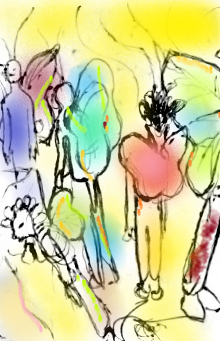‘The time to unleash your depravity is now’
By: Remy Xa, Staff Writer
This Halloween, the freaks will finally come out of their roosts and proliferate in the streets. Observers of this haunting and harrowing fall holiday wear costumes to celebrate a night of giggles and creeps. Sometimes scary, sometimes silly masquerades become celebrants’ second skins for the rest of the evening. This October ritual is a song and dance with which American children have been familiar since toddling days. More seasoned celebrants may come to realize, however, that Halloween is a very strange tradition as a whole.

Halloween is a favorite time of year because it celebrates difference, strangeness, and freedom of expression. There is no better way to boldly defy the inevitable end of the world than dressing in a silly costume and reveling in this absurdity. From the intricate rituals of choosing a character one loves, to the actual acquisition and wearing of a Halloween costume, it is no surprise why many find the process incredibly personal to their own life experiences. After a long year of hard work, every person deserves a bit of life and levity. Sometimes this means wearing a silly wig or putting on some dramatic character makeup. Spending some time in creating a fun Halloween costume is the perfect way to nurse a tired soul after a year of forced social niceties and exhausting obedience.
Up until the 19th century, the tradition of Halloween was known as Samhain (“SOW-win”), a traditional Gaelic festival celebrating the end of the harvest season. Samhain was held from October 31st to November 1st and ushered in the dark half of the year.
However, in the mid-14th century, the Catholic Church saw Samhain and its blasphemous rites as a threat to the church and to good Christian morality. It wasn’t until Pope Gregory IV set the date of All Hallow’s Day, a Catholic celebration of saints, to November 1st, did the name of the pagan tradition become replaced with the more church-friendly name “Halloween”, meaning saints’ evening. As a result, this expression of cultural identity has been co-opted and twisted across the Western world. However, no amount of whitewashing will ever remove the cherished supernatural elements from this revered holiday.
Falling between seasons, Samhain was thought to occur during a liminal period where the passage to the otherworld was thinned. Festival attendees would enjoy the year’s bounty, drink in joy, and go door to door in costume asking for food. (St. Louisans might know a similar charm to perform in order to receive their just candy dessert: tell joke, get candy.) Celebrants also lit bonfires and played divination games to foretell the future, not unlike today’s campfires and Ouija board scryings. Despite intervention from the Catholic church, the haunting holiday of Halloween will always commemorate a long year of labor with otherworldly fun and delight. No societal norms can eradicate these profane delights.
This year, remember Halloween’s history of oppression before deciding to go to the party in plainclothes. Deciding what to wear can be anxiety inducing, but remembering the holiday’s roots in freedom and self-expression is a great way to overcome doubt. Even if it is just going out as a favorite character from “The Office” or “Parks and Recreation” with pieces from one’s wardrobe, getting in the Halloween spirit is as simple and easy as one makes it. For those who already have a costume from a previous year in the closet, there is no shame in wearing an old look either, so long as one promises to uphold the spirit of their character. Wearing costumes embodying personal heroes is fun and personally gratifying.
For all those who have spent their lives feeling held down by the systems of power, Halloween is the one night of the year where it is socially acceptable to unleash one’s own heathenry. The time has come to live out inner truth. Choose expression over censorship this holiday, and you just might find that life is a little more sweet in the shoes of a free man wearing a silly costume.










